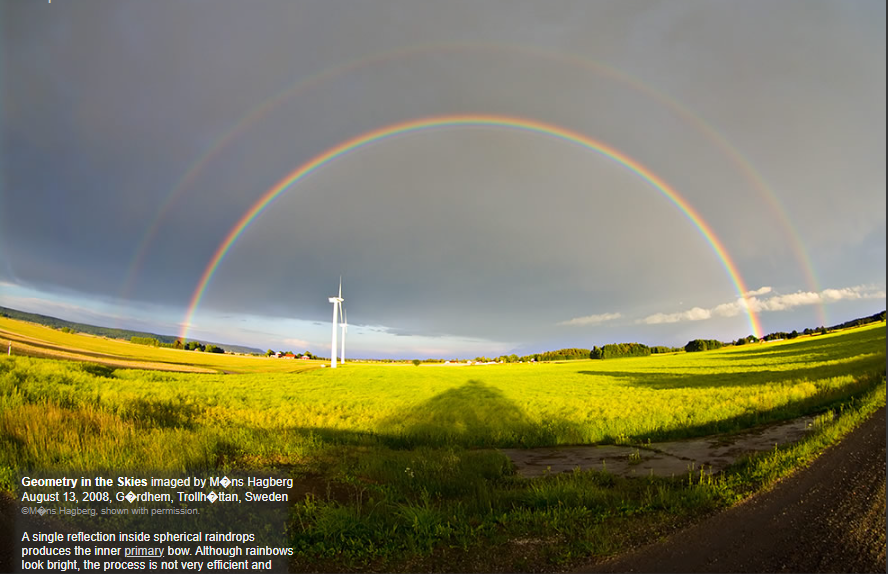Geometry in the Skies
Geometry in the Skies: Unveiling the Secrets of Atmospheric Optics
Have you ever gazed up at the sky and marveled at the breathtaking display of colors and patterns? The phenomenon you are witnessing is known as atmospheric optics, where light interacts with the Earth's atmosphere to create mesmerizing optical effects. One intriguing aspect of this field is the role of geometry in shaping these celestial spectacles. In this article, we will delve deeper into the fascinating world of "Geometry in the Skies" and explore the intricate interplay between light, raindrops, and reflections.
At the heart of many atmospheric optical phenomena lies the interaction between sunlight and raindrops. When sunlight passes through raindrops, it undergoes a series of reflections and refractions that give rise to various optical phenomena. One such phenomenon is the primary rainbow, which occurs when sunlight is reflected inside spherical raindrops. The inner primary bow forms when a single reflection takes place, resulting in a bright arc of colors. However, it is important to note that this process is not very efficient, with only around 5% of sunlight being reflected.
As sunlight undergoes a single reflection inside raindrops, it gets deviated by approximately 140 degrees. This deviation causes the formation of a bright-edged rainbow disk with a radius of 42 degrees. This disk is responsible for the vivid colors and distinctive shape of the primary rainbow that we often observe in the sky. It's truly remarkable how something as simple as a raindrop can create such a dazzling display!
But the wonders of atmospheric optics do not end there. Beyond the primary rainbow lies another captivating phenomenon known as the secondary rainbow. The secondary rainbow is formed by two internal reflections within raindrops, which deflect sunlight through an angle greater than 231 degrees. This deflection results in a lighter sky with a bright-edged hole at its center, having a radius of 51 degrees. The secondary rainbow is often fainter than the primary rainbow, but its presence adds an extra layer of beauty to the atmospheric canvas.
While geometric optics play a crucial role in explaining the formation of primary and secondary rainbows, there are certain aspects that defy geometric explanations. One such puzzling feature is the appearance of colored fringes known as supernumerary bows. These fringes, which can be observed on the inner edge of rainbows, cannot be fully explained by geometric optics alone. Instead, they arise due to the wave nature of light and interference effects within the raindrops. The interplay between diffraction and interference causes these delicate bands of colors to emerge, adding a touch of mystery to the already enchanting world of atmospheric optics.
As we delve deeper into the realm of atmospheric optics, we uncover more intriguing phenomena related to geometry in the skies. One example is the glory, a captivating optical phenomenon that occurs when sunlight is scattered backwards by tiny water droplets or small ice crystals in clouds. The glory appears as a set of concentric colored rings surrounding the shadow of the observer, creating an ethereal halo-like effect. The size and appearance of the glory are influenced by the size and shape of the water droplets or ice crystals, making it a fascinating subject of study for researchers and enthusiasts alike.
Another mesmerizing phenomenon related to geometry in the skies is the circumzenithal arc. This arc appears as an upside-down rainbow located directly above the sun, forming a graceful arc shape in the sky. It occurs when sunlight is refracted through horizontally oriented ice crystals in cirrus clouds. Due to the specific orientation of these ice crystals, the light undergoes a unique bending angle, resulting in the formation of this awe-inspiring celestial arc.
In addition to rainbows, glories, and circumzenithal arcs, there are numerous other atmospheric optical phenomena that owe their existence to the intricate interplay between light and geometry. From the elusive green flash observed during sunrise or sunset to the captivating displays of light pillars and halos, the skies never cease to amaze us with their geometric wonders.
In conclusion, the study of atmospheric optics reveals the profound influence of geometry on the mesmerizing optical phenomena that grace our skies. From rainbows to glories, these celestial spectacles are a testament to the intricate interplay between light, raindrops, and reflections. While geometric optics provide a solid foundation for understanding many of these phenomena, there are still aspects that elude explanation. The next time you find yourself gazing up at the sky, take a moment to appreciate the hidden geometry that shapes the breathtaking beauty above us.

Geometry in the Skies imaged by M�ns Hagberg August 13, 2008, G�rdhem, Trollh�ttan, Sweden. ©M�ns Hagberg, shown with permission.
A single reflection inside spherical raindrops produces the inner primary bow. Although rainbows look bright, the process is not very efficient and most sunlight passes through the drops without being reflected. The 5% or so that is reflected once gets deviated 140� and more to form the bright edged rainbow disk of 42� radius.
Two internal reflections deflect sunlight through 231� and more to form lighter sky with a bright edged hole of 51� radius at its center - the secondary rainbow. More than two reflections?
Geometry does not completely rule. The coloured fringes, supernumerary bows, cannot be explained by geometric optics.

Note: this article has been automatically converted from the old site and may not appear as intended. You can find the original article here.
Reference Atmospheric Optics
If you use any of the definitions, information, or data presented on Atmospheric Optics, please copy the link or reference below to properly credit us as the reference source. Thank you!
-
<a href="https://atoptics.co.uk/blog/geometry-in-the-skies/">Geometry in the Skies</a>
-
"Geometry in the Skies". Atmospheric Optics. Accessed on November 16, 2024. https://atoptics.co.uk/blog/geometry-in-the-skies/.
-
"Geometry in the Skies". Atmospheric Optics, https://atoptics.co.uk/blog/geometry-in-the-skies/. Accessed 16 November, 2024
-
Geometry in the Skies. Atmospheric Optics. Retrieved from https://atoptics.co.uk/blog/geometry-in-the-skies/.